Transitioning From Full-Time Job to Full-Time Freelancing
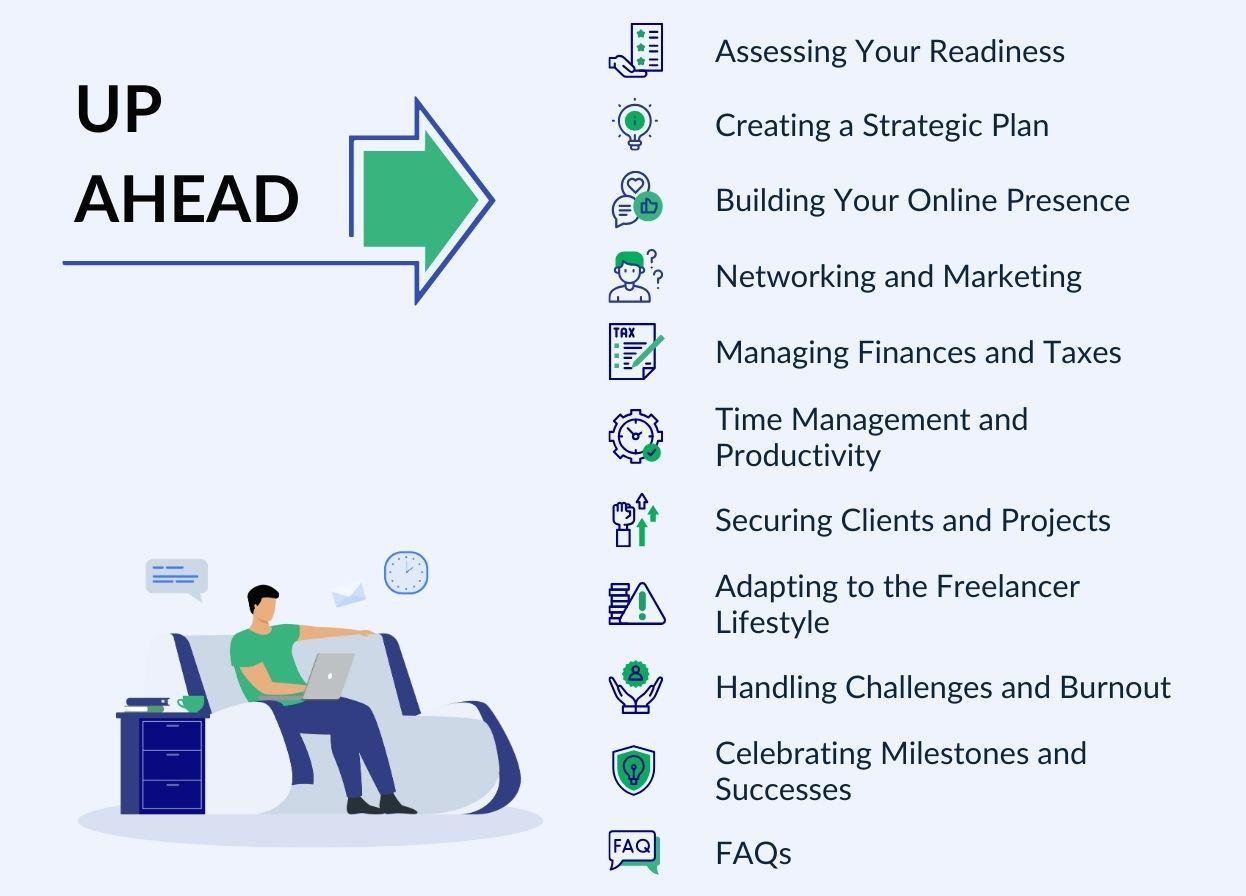

Earlier, employees tired of working a 9-to-5 job often turned to one of the three: IAS, MBA, or Startup. However, with the rise of the gig economy, you may want to start freelancing to earn a side income or transition to being your own boss.
According to the World Bank, nearly 47% of workers worldwide work as freelancers. Even the global freelance platform market will reach $9.19 billion by 2027.
While the freedom of working from anywhere, setting your own prices, pursuing your passion, and having more control over your life is good, it also comes with irregular income, lack of benefits, isolation, competition, and uncertainty.
This article will guide you through the steps and tips for successfully transitioning from a full-time job to a full-time freelancing job.
Assessing Your Readiness
Before quitting your full-time job and diving into freelancing, you must ask yourself some important questions.
- Do you have enough savings to cover your living expenses for at least six months?
- Do you have a solid portfolio that showcases your skills and experience?
- Do you have a diverse skill set that distinguishes you from other freelancers?
- Do you understand the freelance market and the demand for your services?
These questions will help you evaluate your financial stability, professional credibility, competitive advantage, and market opportunity. If you answer yes to all of them, then you are ready to take the next step. If not, you need to improve these areas before making the transition.
Here are some tips on how to assess your readiness.
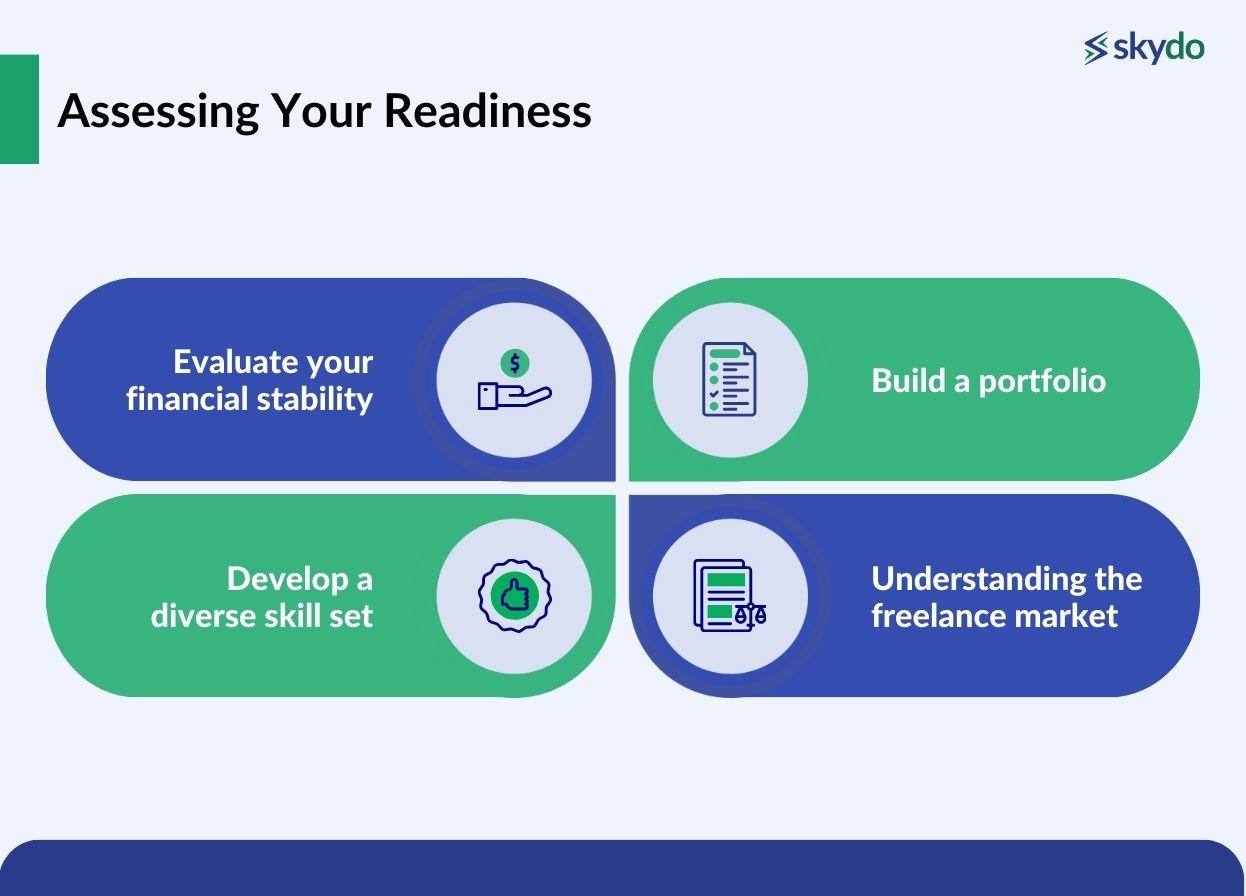
- Evaluate your financial stability
Save enough money to cover your living expenses for at least six months. This will give you a cushion in case you don’t land enough clients or projects right away.
- Build a portfolio
Your portfolio is your best tool to showcase your skills and experience to potential clients. Make sure it is updated, relevant, and professional. Include samples of your best work, testimonials from previous clients or employers, and any awards or recognition you have received.
- Develop a diverse skill set
The more skills you have, the more value you can offer clients. You can take online courses, read books and blogs, watch videos and podcasts, or attend workshops and webinars.
- Understanding the freelance market
You need to research the demand for your services in the freelance market. You should also know your target market and niche, their needs and pain points, how much they are willing to pay for your services, and who your competitors are.
Creating a Strategic Plan
Once you have assessed your readiness, you must create a strategic plan that outlines your goals and objectives, defines your target market and niche, estimates your income and budgeting, and identifies potential challenges and solutions.
Here are some tips on how to create a strategic plan.
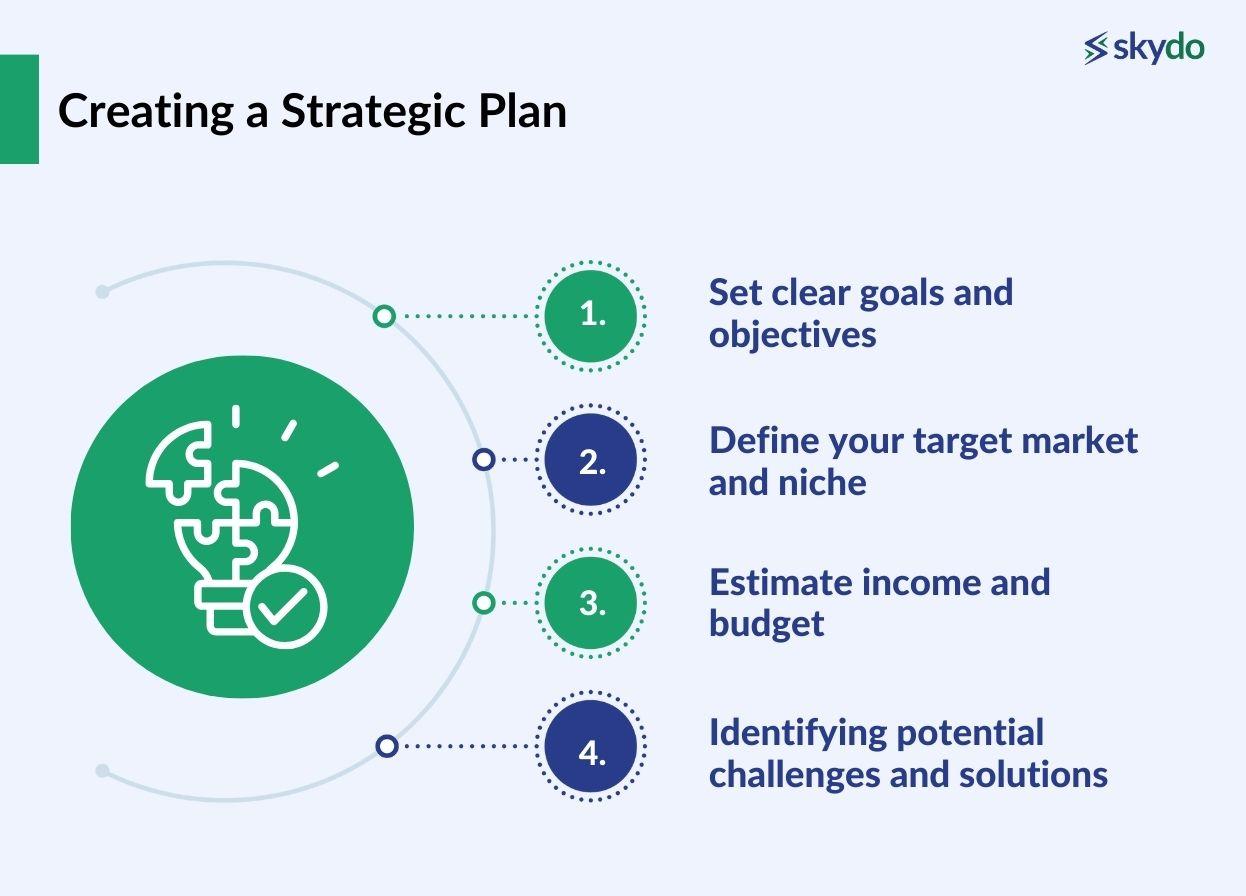
- Set clear goals and objectives
Your goals and objectives should be specific, measurable, achievable, relevant, and time-bound (SMART). For example, instead of saying, “I want to earn more money as a freelancer,” say, “I want to earn ₹50,000 per month as a freelance web developer by December 2023”.
- Define your target market and niche
Your target market is the people/businesses needing your services. Your niche is the specific area or industry that you specialize in. For example, if you are a freelance web developer, your target market could be small businesses that need websites. Your niche could be e-commerce websites for fashion brands.
- Estimate income and budget
You need to estimate how much income you can earn as a freelancer based on your rates, hours worked, number of clients or projects, etc. You must also budget for taxes, insurance, equipment, software, etc.
- Identifying potential challenges and solutions
You need to anticipate the challenges and risks you may face as a freelancer, such as finding clients, managing projects, dealing with late payments, handling legal issues, etc.
Have contingency plans and solutions for each challenge, such as having a backup client, using a project management tool, setting up a payment system, hiring a lawyer, etc.
Building Your Online Presence
Before you quit your job and start looking for clients, try to create your presence in the freelance world while working your full-time job.
Your online presence is your digital footprint that shows who you are, what you do, and how you can help your clients. It includes your freelance brand, professional website, social media profiles, portfolio, and testimonials.
Here are some tips on how to build your online presence.
Craft a compelling freelance brand
Your freelance brand is how you present yourself to your clients. It includes your name, logo, tagline, mission, values, tone, etc. It should be consistent, authentic, and memorable.
You can create your brand on something as simple as your LinkedIn page. If you want something more elaborate, you can go for a website (like this one by Kaleigh Moore, a well-known freelance writer, which gives a clear idea of who she is, what she does, and how she can help clients grow).
Create or update your professional website
Your website showcases your services, portfolio, testimonials, contact info, etc. This means you use your website to display what you do, what you have done, what others say about you, how to reach you, and so on. A website can help you to–
- Attract potential customers or clients who are looking for your services or products online
- Establish your credibility and reputation as a professional or a business
- Communicate your value proposition and unique selling points to your target audience
- Engage with your visitors and encourage them to take action (such as contacting you, subscribing to your newsletter, buying your products, etc.)
- Build trust and loyalty with your existing customers or clients by providing them with useful information, updates, support, etc.
Optimize your social media profiles
Your social media profiles are where you connect with your clients, peers, and influencers. Use the platforms that suit your industry and audience.
For example, a B2B SaaS writer may find their ideal clients (SaaS brands) on LinkedIn, whereas a social media manager might find it easier to reach out to D2C brands on Instagram.
Showcasing your portfolio and testimonials
Your portfolio and testimonials show your potential clients or employers what you can do and how you have helped others in the past. They are essential for building trust and credibility and demonstrating your value and results.
For example, suppose you are a freelance web developer who wants to attract more clients. You could create a portfolio website that showcases your best work and testimonials from previous clients or employers.
Your portfolio website could include the following elements.
- A brief introduction about yourself, your skills, and your services.
- A list of your projects, with links to the live websites or screenshots of the work. You could also include a brief description of each project, highlighting the main features, challenges, and solutions.
- A section for testimonials, where you display the feedback and reviews from your previous clients or employers. You could also include their names, titles, and logos to increase credibility.
- A contact form or a call-to-action button invites visitors to contact you for a quote or a consultation.
Here is an example of a portfolio website that follows these guidelines: Lokkee Studios
Networking and Marketing
This is an extension of creating your presence, but here, you are more actively looking for people that you can work with. Networking and marketing are essential activities that help you find and attract clients for your freelance business. They involve reaching out to people who can help you grow your network, reputation, and income.
Here are some tips on how to network and market yourself:
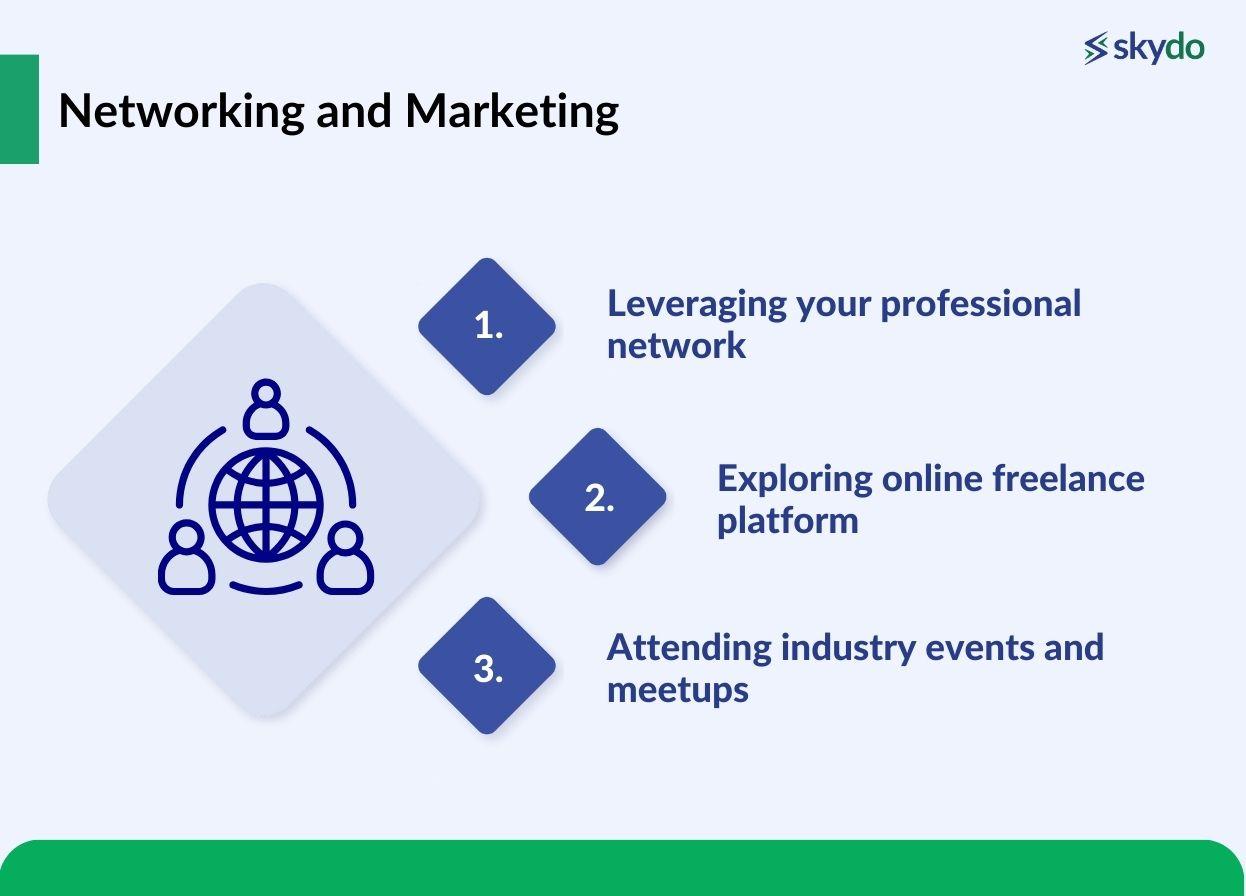
- Leveraging your professional network
Your professional network comprises people who know and trust you. They include your former coworkers, bosses, clients, friends, family, etc. You can use them by asking for referrals, recommendations, introductions, etc.
For example, you can email your previous employer and ask them to write a testimonial for your website or portfolio. You can also ask your friends or family to share your services on their social media accounts or introduce you to potential clients in their circles.
- Exploring online freelance platforms
Online freelance platforms are websites that match freelancers with clients who need their services. They include platforms such as Freelancer.com, Upwork, Fiverr, etc. You can use them by creating a profile, browsing projects or gigs, sending proposals or bids, etc.
Start by creating a profile on any platform to showcase your skills, experience, and portfolio. Search for projects that match your expertise and budget. Then, write a customized proposal highlighting your value proposition and why you are the best fit for the job.
- Attending industry events and meetups
Industry events and meetups are offline chances to meet and interact with people who share your interests or goals. They include conferences, workshops, seminars, webinars, podcasts, etc.
One way to find such events is by being active in freelance groups on Facebook and communities on LinkedIn. Working from coworking spaces can also provide a unique opportunity to meet like-minded folks in the freelance industry and potential clients.
Learn how to find high-paying remote opportunities here.
Managing Finances and Taxes
Just finding clients and creating an income for yourself is not enough. Freelancers are responsible for managing their finances and taxes. You must keep track of your income and expenses, invoice your clients and collect payments, pay your taxes, comply with the law, and plan for your future.
Here are some tips on managing your finances and taxes:
- Setting up a dedicated business bank account to track your cash flow, transactions, income, and expenses.
- Establishing a clear invoicing and payment process: Make a professional invoice template with your contact info, payment terms, services, fees, etc. Additionally, you should be able to accept various payment methods, such as PayPal, Stripe, etc. Learn more about how you can streamline international transactions here.
- Understanding self-employment taxes and obligations: You should know the tax laws and regulations for freelancers in your country or state. It is also important to know how to calculate your taxes, such as income tax, sales tax, VAT, etc.
For example, a self-employed individual in India must file their income tax returns using the ITR-4 or ITR-4S form, depending on whether they opt for presumptive taxation. may also have to pay other taxes such as GST (Goods and Services Tax), TDS (Tax Deducted at Source), TCS (Tax Collected at Source), etc., depending on the nature and turnover of their business or profession.
Time Management and Productivity
As a freelancer, you can set your hours and schedules. However, you must also deal with multiple projects, deadlines, clients, and distractions. You must manage your time effectively and efficiently to deliver high-quality work and meet your goals.
Here are some tips on managing your time and productivity:
- Create a realistic work schedule that suits your preferences, lifestyle, and workload.
- Use various time management techniques to help you organize your work, prioritize tasks, avoid procrastination, etc. One popular time management technique is the Pomodoro Technique, where you work on a task for 25 minutes without interruptions, then take a 5-minute break to relax and refresh your mind, and repeat this cycle until you finish the task or reach your goal.
- Another tool that can help is the Eisenhower Matrix, which helps prioritize tasks by urgency and importance so you can decide what to do, schedule, delegate, or delete.
- Find a healthy balance between work hours and personal time. Don’t overwork yourself or neglect your needs; make time for hobbies, leisure activities, social interactions, etc.
For example, you can start your day by engaging in a physical activity that invigorates your mind and takes short breaks throughout the work day to take a walk. You can also avoid checking emails or taking calls after 5 pm unless it is an emergency.
Securing Clients and Projects
Before you become a full-time freelancer, you need to have a roaster of study clients to sustain your income and grow your business. You must impress potential clients with your pitches and proposals, build rapport with them, navigate negotiations and contracts, deliver high-quality work, and exceed their expectations.
Here are some tips on securing clients and projects:
- Make pitches and proposals that match your potential client’s needs and pain points. This means that you should do some research on your potential clients before you pitch or propose your freelance work to them.
Find out what their goals, challenges, preferences, and expectations are. Then, tailor your pitches and proposals to show how your skills can help them solve their problems, achieve their objectives, and add value to their business. - Build a positive and professional relationship with potential clients by communicating clearly and promptly, asking questions, listening actively, etc. For example, if you cannot meet a predetermined deadline, communicate it to the client early rather than just not completing the work on time. It can sour your relationship and even cost you the job.
- Learn to negotiate the terms and conditions of your freelance work. Know your worth and your minimum acceptable rate, but also be flexible and realistic about your fees. You should also be clear about the scope of your work, the deliverables you will provide, the deadlines you will meet, the revisions you offer, and any other terms and conditions relevant to your project. Also, don’t forget to have a written contract that details both parties’ expectations.
- Lastly, deliver your work on time, budget, and quality. Ask for feedback and testimonials from your clients, and sometimes, try to go beyond expectations with your work.
Adapting to the Freelancer Lifestyle
For someone who doesn’t have to work a 9-5 anymore, the freedom that comes with freelancing might feel very liberating. But it can also be challenging to manage your time without external deadlines. As a freelancer, you can pick your projects, clients, and schedule. But you also need to be flexible, disciplined, and resilient.
Here are some tips on how to adapt to the freelancer lifestyle:
- Accept that freelancing is not a stable or predictable source of income, and prepare for periods of high or low demand for your services by diversifying your income streams by having multiple clients or projects, passive income sources, especially if your goal is to make money from home consistently.
- Develop a strong work ethic and a positive mindset that will help you stay focused and productive.
- Avoid feeling lonely or isolated by connecting with other freelancers or professionals in your industry or niche.
- Never stop learning new skills or improving your existing ones.
Handling Challenges and Burnout
So, you now have the freedom to choose your projects and clients, but you also face uncertainty and stress. How can you cope with the ups and downs of freelancing?
Here are some tips on how to handle challenges and burnout:
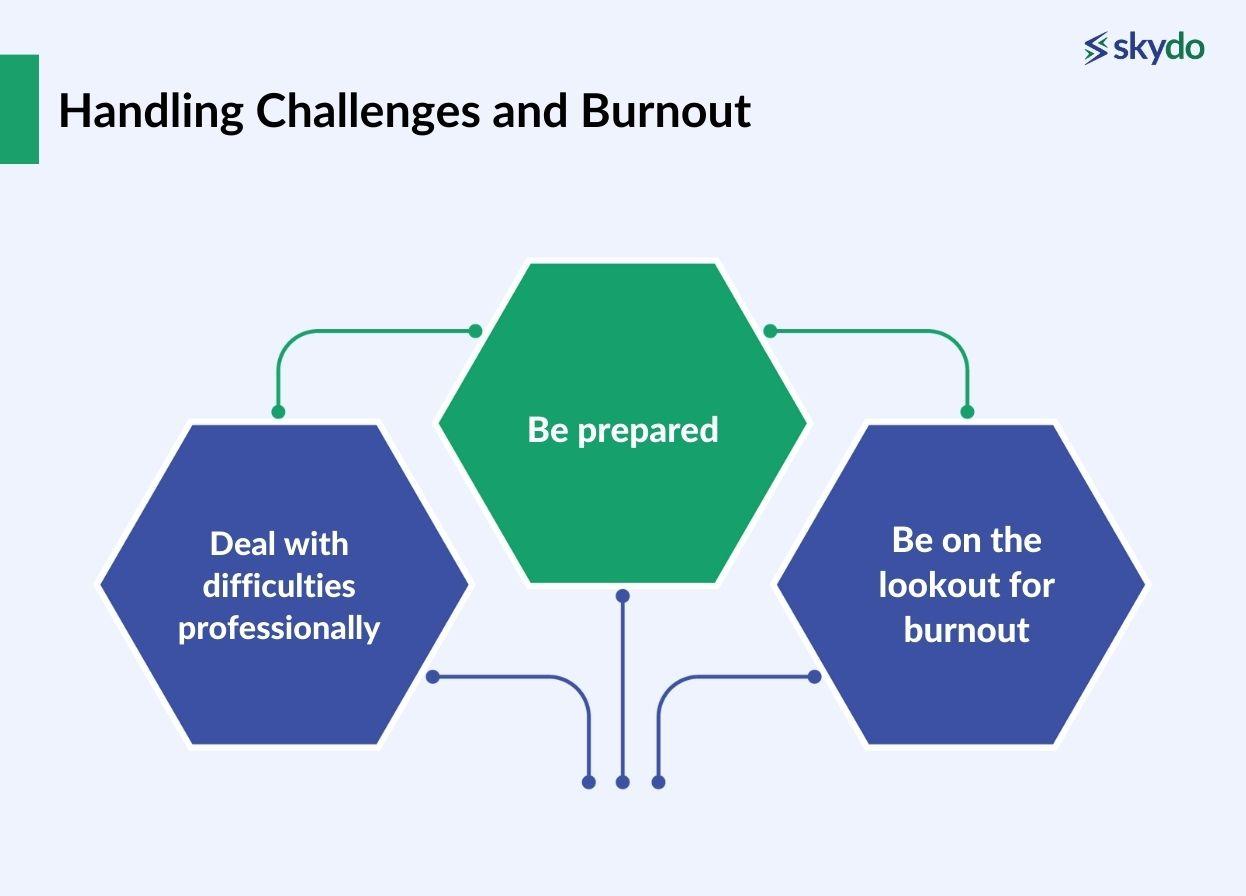
- Be prepared
Plan, save, and market your services consistently to cope with income and workload fluctuations. This will help you be prepared in case one of your clients suddenly decides to stop working with you, leaving you in a drought.
- Deal with difficulties professionally
Resolve issues professionally, set clear boundaries, and know when to quit when dealing with difficult clients or projects.
For example, when you encounter a problem with a client, such as a misunderstanding, a delay, or a complaint, don’t ignore it or get defensive. Instead, communicate with the client respectfully and courteously and try to find a mutually acceptable solution.
However, sometimes, despite your best efforts, you may encounter a client who is impossible to please or work with. In such cases, you may need to consider ending the relationship with the client.
- Be on the lookout for burnout
Watch out for burnout symptoms, take breaks regularly, and practice self-care. Freelancers may be more prone to burnout due to the lack of clear boundaries between work and personal life, the pressure to meet deadlines and client expectations, and the isolation of working alone.
Some common signs of burnout are fatigue, headaches, changes in appetite or sleep, feeling helpless, cynical, or detached, and losing interest or motivation in work. To prevent or cope with burnout, watch out for these symptoms and take steps to restore their well-being.
Some helpful tips are to take regular breaks throughout the day, set realistic and manageable goals, prioritize self-care activities such as exercise, meditation, or hobbies, and seek social support from friends, family, or other freelancers.
Celebrating Milestones and Successes
Transitioning from full-time to freelancing can be challenging, and you must take care of yourself along the way. You have earned the right to reward yourself for your efforts and achievements, whether big or small.
Here are some tips on celebrating your milestones and successes:
- Celebrate your freelance milestones with a smile and a splurge on things/experiences you’ve wanted to get for a long time.
- Push yourself to the next level of freelancing with ambitious and attainable objectives.
- Tell your freelance story to the world through social platforms or freelance communities) and spark a flame in others.
- Love your freelance life and be grateful for the perks and possibilities.
Conclusion
Transitioning from a full-time job to full-time freelancing can be a rewarding and fulfilling career move. However, it also comes with its own challenges and risks.
To succeed as a freelancer, you must have a clear vision of your goals, a realistic plan of action, and a strong support network. You must also be prepared to deal with the uncertainty, isolation, and competition that freelancing entails.
Following the tips and advice in this blog can make the transition smoother and more enjoyable. Remember, freelancing is not for everyone, but it can be the best decision you ever make if you have the passion, skills, and mindset.
Frequently Asked Questions
Q1. How can I assess if I'm ready to transition from a full-time job to freelancing?
Ans: Before making the leap, consider factors like having at least six months' worth of living expenses saved, a robust portfolio showcasing your skills, a diverse skill set, and a clear understanding of the freelance market and the demand for your services.
Q2. How do I evaluate my financial stability for freelancing?
Ans: Assess your financial stability by saving enough money to cover living expenses for at least six months. This financial cushion helps in case you don't secure clients or projects immediately.
Q3. How do I manage my finances and taxes as a freelancer?
Ans: Manage finances by setting up a dedicated business bank account, establishing a clear invoicing and payment process, and understanding self-employment taxes and obligations in your country or state.












